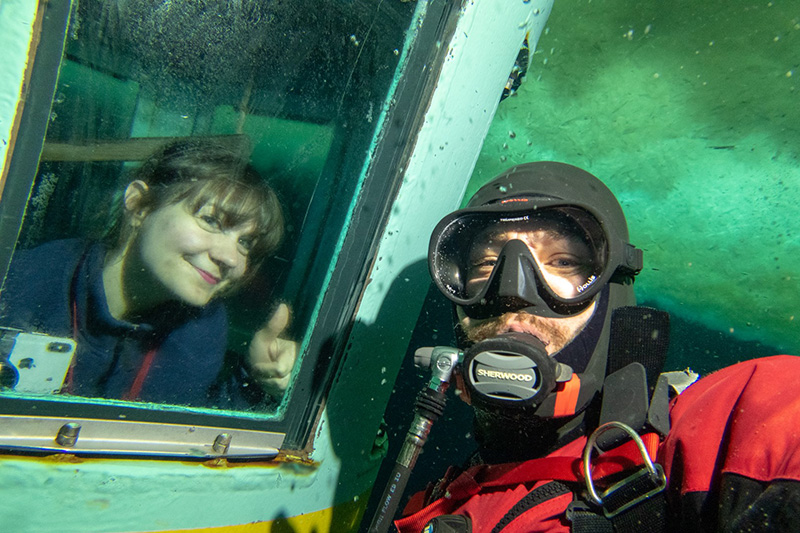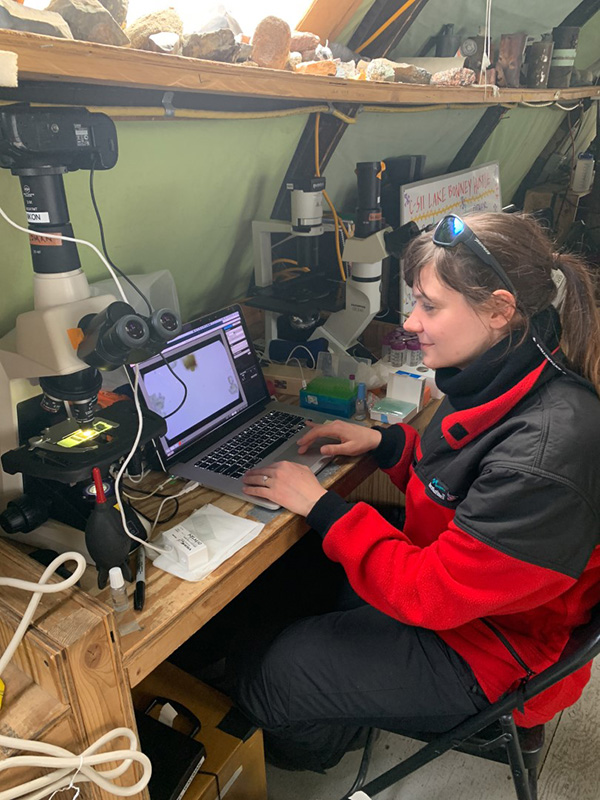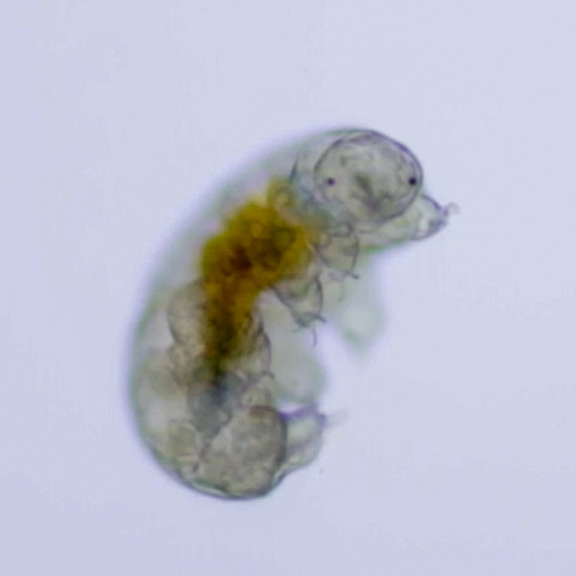
Photo Credit: Steve Rupp |
Ariel Waldman gives the thumbs up in the Observation Tube that extends under the frozen sea ice, along with diver Steve Rupp. |
Hacking Science with Microscopic Photography
Looking At Antarctica's Extremophiles Like Never Before
By Elizabeth Delaquess, ANTARCTIC SUN GUEST WRITER
Posted June 3, 2019
Ariel Waldman is a true renaissance woman. As an artist, author, innovation advisor, and scientist (often all at the same time) she built a career fueled by her passion for making science as accessible as possible.

Photo Credit: Ariel Waldman
At the Lake Bonney field camp, Walman focuses her microscope in on several microorganisms collected at the nearby lake.
She spent five weeks in Antarctica collecting and photographing microorganisms that live in the glaciers, sea ice and ponds in the Dry Valleys and on Ross Island. The images and video she captured will be the basis for an upcoming web-based project that she hopes will enable scientists to create more interactive work and make science more approachable to all audiences.
She came to the icy continent as part of the National Science Foundation's Artists and Writers Program, which supports selected individuals traveling to Antarctica for their work.
Ultimately, Waldman will stitch together her collected images and video into an interactive website that viewers can navigate through. The idea is to have a kind of animated "Google Maps" of an imagined water drop for people to explore and learn about the many extremophiles that live on the continent.
There's a practical as well as artistic reason for this kind of microscopic photography. Waldman hopes these images will make the study of tiny creatures in Antarctica more accessible for non-science audiences.
"A lot of time scientists come down here, do DNA sequencing and let you know what's going on. Then they take one or two photos which go into a scientific paper, and that's it," Waldman said. "You could do a lot of interesting things with that information, or you could invite people to collaborate and find ways to mash it up with other data sets, but for the most part [scientists] open things up and then say, 'we're done.' That frustrates me because most of that content is still not very accessible."

Photo Credit: Ariel Waldman
A tiny tardigrade, also known as a water bear, was one of the many extremophiles imaged by Waldman.
Advocating for citizen scientists and science accessibility has been a focal point in Waldman’s career for many years. She is perhaps best known in the science community as the global director of “Science Hack Day,” an international collaborative project that brings people from a wide range of backgrounds together to collaborate, share data, and work together in ways that they might not be able to in a more traditional academic setting.
Waldman also worked for NASA's CoLab project, which fosters collaboration between communities in and outside of NASA. She has also presented a Ted Talk, received awards from the White House and grants for her work, and recently published the book What's It Like In Space?: Stories from Astronauts Who've Been There.
Waldman grew up in Kansas and attended the Kansas City Art Institute, and began working at NASA after applying to work there "on a whim."

Photo Credit: Pacifica Sommers
Waldman hikes up along the Canada Glacier to join researchers studying microorganisms at the top.
"[I] didn't really have any aspirations to work in science or space, not because I disliked it, just that I didn't think that was where I was headed," she said.
Waldman's interest in science and science advocacy grew while working at NASA, and Antarctica seemed like a logical next step for someone interested in space exploration.
"I think I became an Antarctic geek after becoming a space geek," Waldman said. "I felt like coming to Antarctica was like my own version of going to space. I didn't necessarily want to go to space, but I wanted to find my version. I wanted to find my extreme."
These harsh environments, and the tiny critters that live in them is what attracted her to the frozen continent.
"Antarctica is both an extreme place and it's not, and that’s what my project has been about so far," Waldman said. "I want to show that life can survive in environments that are considered too extreme for humans and other animals. That certainly has implications for space and these places we're finding in our solar system. Places that seem inhospitable but may hold life."

Photo Credit: Mike Lucibella
While at McMurdo Station, Waldman kept her fans around the world up to date on her project through a live telecast from Observation Hill.
Waldman used microscopic photography to capture a range of microorganisms living in various environments around the McMurdo Dry Valleys, including at Blood Falls, and from Ross Island as well.
"I am hooking my cameras up to microscopes and trying to capture most microorganisms larger than bacteria," Waldman said. "Bacteria is fairly small and not very interesting to look at, but there are so many different types of microorganisms that are larger than [that], like tardigrades and nematodes. What I'm trying to do is specifically capture them in motion."
Waldman hopes that her plan to create an accessible, interactive website serves both non-science communities and researchers from more of an academic background as well. There aren't a lot of images and videos of microscopic creatures from Antarctica widely available, so she hopes it can turn into a tool for researchers to help better communicate what they're working on.
"You don't have a sense of how they walk around, how they move," Waldman said. "I"ve talked to researchers who have seen things with the microscope and couldn’t find info on it, but knew they could get more information with images. So I hope this will be useful to the scientific community both for behavioral studies, and for presentations or other communication needs… I'm trying to make it so that when these images are presented, people playing with them can better imagine things to do with data, and see how they can contribute to this science."









